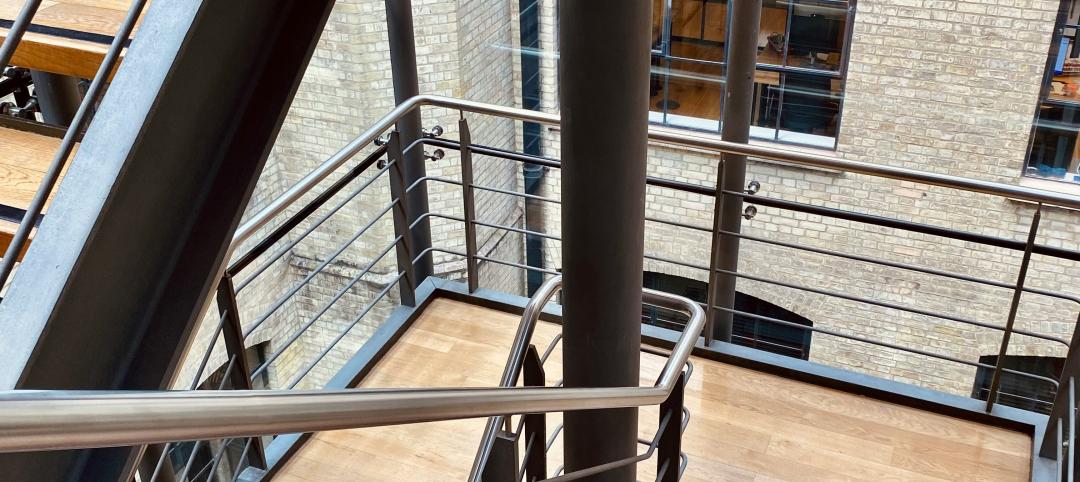When selecting replacement windows and doors for retrofits, Building Teams must consider aesthetics, cost, schedule, view, energy performance, accessibility, and durability. Then there are environmental and security considerations, such as vandal resistance, blast-hazard mitigation, and hurricane-impact protection. Fortunately, new technologies are making it easier to meet those requirements and upgrade the appearance and energy efficiency of a building, while keeping the project on budget.
Compared to the products available 15 years ago, new windows and doors offer greatly improved thermal performance, says John Bendt, sales/marketing vice president with Wausau Window and Wall Systems (www.wausauwindow.com). “That’s because better thermal separators, such as glass-reinforced nylon, provide superior insulation through increased aluminum separation and air space in the frames,” says Bendt.
Fabricated glass continues to improve in insulating value and controlling solar heat gain while letting an appropriate amount of natural light into the building. Triple-insulating glass is also being considered for more projects. “The biggest trend today is toward energy-efficient technologies, including aluminum-clad wood, fiberglass and vinyl frames, and high-performance, low-e glass,” says Terry Zeimetz, commercial marketing manager for Pella Corp. (www.pella.com).
“Aluminum cladding has come a long way in its ability to emulate wood profiles,” notes Jeff Hoffman, an architectural sales representative for Marvin Windows and Doors (http://commercial.marvin.com)
Older windows can be swapped out for new ones that offer similar sightlines and historical look. For example, aluminum-framed, projected windows can be made to look like old steel windows or double-hung windows but are easier to operate, says Bendt. Aluminum cladding is frequently used in historically influenced replacement windows because it’s durable and easy to customize. Factory-applied anodized and baked-on fluoropolymer paint finishes can be formulated to match existing color schemes or reproduce a building’s original colors. Such finishes are also eco-friendly.
Commercial doors can be specified with components and technologies to address constantly increasing thermal performance requirements. “Many types of high-performance glass, including those that withstand blasts and hurricane impact, can be incorporated without altering the overall look of a door,” says Mary Olivier, marketing manager for Tubelite Inc. (www.tubeliteinc.com), a manufacturer of architectural aluminum window, entrance storefront, and curtain wall systems.
Durability is a key factor in selecting a door/hardware combination and the size of the stiles (the vertical members of the door frame). But the most significant task in replacement projects, particularly for historic buildings, is to match the work of historic artisans using modern materials on a limited budget, Olivier says.
Deciding whether or not to use the existing window and door framing in a retrofit depends on such factors as the presence of wood rot and hazardous materials, the structural integrity of the existing frame, and the anchorage scheme of the replacement system, says Ken Brenden, CDT, of the American Architectural Manufacturers Association (www.aamanet.org), Schaumburg, Ill.
Bendt points out that older window frames don’t offer modern-day thermal technology and performance, so it’s worthwhile to evaluate new frames for their potential energy savings and reduced maintenance. Ultimately, the decision to keep or tear out existing framing should be based on energy modeling and budgeting information, he says.
Let’s take a look at a few instructive window/door retrofits.
[pagebreak]
UNIVERSITY RESIDENCE HALL UPGRADE: SAVE ENERGY, IMPROVE AESTHETICS
Eastern Michigan University, Ypsilanti, Mich., completed a $3.1 window renovation last year on its First-Year Center, a freshman residential hall that dates back to the 1960s. More than 675 operable, high-performance windows were installed.
Energy conservation and improved aesthetics were the primary goals, says architect Sandra Laux, AIA, of Detroit-based Hamilton Anderson Associates (www.hamilton-anderson.com). To replace the single-pane glazed windows with insulated units, Laux selected Wausau low-profile windows. Their aluminum frames have a copper anodized finish to contrast with the blond brick exterior. The low-maintenance, durable finish is expected to maintain its color over time without forming a patina.
The renovation also included replacement of the exterior doors and curtain wall system. “The stair towers had single-glazed curtain wall from the 1960s, which was failing,” says Hamilton Anderson’s Michael Decoster.
Decoster specified EFCO curtain wall and storefront framing systems for the stair towers and entry canopy. The existing concrete canopy rested on small steel columns and was “a really heavy mass” hanging over the entry. “We took that all off the structure and reclad the canopy in curtain wall framing, so on each side of the entry are two-foot-tall pieces of glass that are structurally glazed,” he says. The frosted glass is backlit at night.
OREGON STATE HOSPITAL: RESPECT FOR HISTORY
In 2008, the Oregon State Hospital (OSH) campus, in Salem, was granted national historic landmark status. A complete structural renovation wasn’t an option, but J Building, an 1883-vintage four-story structure designed in the Kirkbride style of psychiatric facilities—and made famous as the setting of the film “One Flew Over the Cuckoo’s Nest”—was restored and refurbished.
To bring the building up to 21st-century standards and seismic requirements, workers removed asbestos and lead paint, added steel rebar, layers of sprayed concrete, and new wood beams, and restored the original cupola.
But the grandest undertaking was the replacement of more than 500 windows on the street side of the building. “It was important to preserve as many historic features as possible,” says Patricia Feeny, communications manager for the OSH Replacement Project. “At the same time, we had to meet state-mandated energy and safety requirements.”
Wausau fabricated windows with sash muntins to match the originals in material and design. The psychiatric-grade windows were drop-tested for interior human impacts of up to 2,000 foot-pounds of energy. The aluminum frames have a resin-based coating that resists humidity, color change, chalking, gloss loss, and chemicals.
5 TIPS for a successful door and window retrofit
1. Analyze products on a level playing field using American Architectural Manufacturers Association and National Fenestration Rating Council (www.nfrc.org) standards and test sites. As you’re calculating ROI, be sure to factor in the savings that may come from being able to downsize the HVAC system, cut repair and maintenance costs, and trim energy costs due to better insulating value and more natural light.
2. Work with the manufacturer’s local architectural representative in the early stages of the project. Trained reps can help with site inspection, drawings, field measurements and testing, energy modeling, mockups, budgeting, detail support, and specification support.
3. Take advantage of AAMA publications on door and window selection criteria, design considerations, window and exterior door types, performance requirements and testing, and accessory items and special features: http://www.aamanet.org/general/1/45/publication-store.
4. Select an installer who will ensure a safe, hassle-free installation while minimizing disruptions to building occupants. Your manufacturer can assist you in finding the right installer.
5. Use moderate door heights and widths, especially when using insulated or specialty glass. Large entrances also have increased size and weight, which places additional strain on hinging hardware and can shorten the door’s longevity.
MITCHELL HALL AT UNM: HOMAGE TO THE PAST
Mitchell Hall, one of the oldest classroom buildings at the University of New Mexico, was built in 1954. While not a registered historic landmark, the building is noteworthy for its design by John Gaw Meem IV (1894-1983), one of the Southwest’s most influential architects.
In tackling the renovation, Albuquerque-based Hartman + Majewski Design Group (designgroupnm.com) sought to preserve the building’s historic integrity while improving its environmental sustainability. The original single-pane, steel-framed windows had narrow sightlines and were stacked vertically with one-inch widths between glazings.
“Part of the goal was to maintain the exterior feel of the project so that the university could, in the future, pursue putting [the building] on the historic registry,” says principal architect Jeff Zellner, AIA, NCARB, LEED AP BD+C.
Hartman + Majewski analyzed the existing window systems and performed energy modeling as part of the LEED certification process. “We looked at improvements that would give us the biggest bang for the buck,” says Zellner.
The team considered a number of options, including true historic steel windows, storefront framing, and aluminum, but ultimately chose Pella fiberglass windows. “We were not familiar with fiberglass windows in commercial applications, but Pella did a pretty good sell on the performance characteristics as well as maintenance,” he says.
With the combined benefit of the new windows, a more efficient mechanical system, and enhanced lighting controls, Mitchell Hall is expected to earn LEED Silver.
THE ST. LOUIS ZOO: REPURPOSING THE ELEPHANT HOUSE
Peabody Hall, the oldest building at the St. Louis Zoo, was completed in 1917. The Renaissance Revival structure, designed by architect George Barnett, served for eight decades as the Elephant House. In 2009, Peabody Hall was renovated to house temporary exhibits in celebration of the zoo’s 100th anniversary. The project was a joint venture of two St. Louis-based design firms, Ottolino Winters Huebner (www.owh-inc.com) and the JCO LLC (www.thejco.com).
According to OWH, the original Elephant House’s masonry, stone, and terra cotta exterior had held up quite nicely over 95-plus years, but the windows and doors were well past their usable life—especially the ornate quatrefoil window in the attic. Finding durable, easy-to-use replacement products that allowed the necessary customization to replicate the form and appearance of the originals became the challenge.
Marvin Windows and Doors fabricated five large transoms, two sets of stationary awning windows, and seven commercial doors (three operating, four fixed) for the renovation. All windows and doors were glazed with black spandrel insulating glass that emulates the look of field-painted glass. To replicate the quatrefoil window, Marvin used five pieces of glass, with true divided lites in the rectangular center section and simulated divided lites surrounding the rectangle. +
Related Stories
Architects | Aug 28, 2024
KTGY acquires residential high-rise specialist GDA Architects
KTGY, an award-winning design firm focused on architecture, interior design, branded environments and urban design, announced that it has acquired GDA Architects, a Dallas-based architectural firm specializing in high rise residential, hospitality and industrial design.
K-12 Schools | Aug 26, 2024
Windows in K-12 classrooms provide opportunities, not distractions
On a knee-jerk level, a window seems like a built-in distraction, guaranteed to promote wandering minds in any classroom or workspace. Yet, a steady stream of studies has found the opposite to be true.
Building Technology | Aug 23, 2024
Top-down construction: Streamlining the building process | BD+C
Learn why top-down construction is becoming popular again for urban projects and how it can benefit your construction process in this comprehensive blog.
Airports | Aug 22, 2024
Portland opens $2 billion mass timber expansion and renovation to its international airport
This month, the Portland International Airport (PDX) main terminal expansion opened to passengers. Designed by ZGF for the Port of Portland, the 1 million-sf project doubles the capacity of PDX and enables the airport to welcome 35 million passengers per year by 2045.
Adaptive Reuse | Aug 22, 2024
6 key fire and life safety considerations for office-to-residential conversions
Office-to-residential conversions may be fraught with fire and life safety challenges, from egress requirements to fire protection system gaps. Here are six important considerations to consider.
Resiliency | Aug 22, 2024
Austin area evacuation center will double as events venue
A new 45,000 sf FEMA-operated evacuation shelter in the Greater Austin metropolitan area will begin construction this fall. The center will be available to house people in the event of a disaster such as a major hurricane and double as an events venue when not needed for emergency shelter.
Cultural Facilities | Aug 21, 2024
Baltimore’s National Aquarium opens 10,000-sf floating wetland that mimics the harbor’s original tidal marsh habitat
The National Aquarium in Baltimore has opened the National Aquarium Harbor Wetland, a 10,000-sf floating wetland that mimics the Inner Harbor’s original Chesapeake Bay tidal marsh habitat. Located between Piers 3 and 4 on Baltimore’s Inner Harbor, the $14 million project features more than 32,000 native shrubs and marsh grasses.
Mixed-Use | Aug 21, 2024
Adaptive reuse of a Sears store becomes luxury mixed-use housing
6 Corners Lofts at 4714 W Irving Park Road, Chicago, Ill., opened in March of 2024 as a 394,000-sf adaptive reuse project born out of a former Sears store.
Building Materials | Aug 19, 2024
Federal 'buy clean' construction materials label program unveiled
The U.S. Environmental Protection Agency announced a plan for implementing a new label program to boost American production of more climate-friendly construction materials and products. The label program will prioritize steel, glass, asphalt and concrete.
Museums | Aug 19, 2024
The Tampa Museum of Art will soon undergo a $110 million expansion
In Tampa, Fla., the Tampa Museum of Art will soon undergo a 77,904-sf Centennial Expansion project. The museum plans to reach its $110 million fundraising goal by late 2024 or early 2025 and then break ground. Designed by Weiss/Manfredi, and with construction manager The Beck Group, the expansion will redefine the museum’s surrounding site.

















